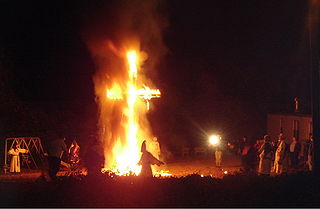 W
WThe Black Sun is a Nazi symbol, a type of sun wheel employed in a post–Nazi Germany context by neo-Nazis and in some strains of Satanism. The symbol's design consists of twelve radial sig runes, similar to the symbols employed by the SS in their logo. It first appeared in Nazi Germany as a design element in a castle at Wewelsburg remodeled and expanded by the head of the SS, Heinrich Himmler, which he intended to be a center for the SS.
 W
WCross burning or cross lighting is a practice associated in modern times with the Ku Klux Klan although it long predates the Klan's inception, as far back as Peter of Bruys, who burned crosses in protest of the veneration of crosses. Since the early 20th century, the Klan burned crosses on hillsides as a way to intimidate and threaten black Americans and other people of color.
 W
WFourteen Words, 14, or 14/88, is a reference to two 14-word slogans set forth and popularized through 14 Word Press — "We must secure the existence of our people and a future for white children", followed by secondary slogan: "Because the beauty of the White Aryan woman must not perish from the earth." Both originated with American white supremacist David Lane, one of nine members of the defunct domestic terrorist group The Order, and serve as a rallying cry for militant white nationalists across the globe. The 8s in the latter half of "14/88" have been used outside of 14 Word Press to represent the eighth letter of the Latin alphabet (H), and "HH" stands for "Heil Hitler".
 W
WAlthough the Confederate States of America dissolved at the end of the American Civil War, its battle flag has continued to receive modern display. The modern display began during the 1948 United States presidential election when it was used by the Dixiecrats, a political party that opposed civil rights for African Americans and supported racial segregation. Further display of the flag was a response to the civil rights movement and the passage of federal civil right laws in the 1950s and 1960s.
 W
WThe OK gesture or OK sign or ring gesture is performed by connecting the thumb and index into a circle, and holding the other fingers straight or relaxed away from the palm. Commonly used by divers, it signifies "I am OK" or "Are you OK?" when underwater. In most English-speaking countries it denotes approval, agreement, and that all is well or "okay". In other contexts or cultures, similar gestures may have different meanings or connotations including those that are negative, offensive, financial, numerical, devotional, political, or purely linguistic.
 W
WPepe the Frog is an Internet meme consisting of a green anthropomorphic frog with a humanoid body. Pepe originated in a 2005 comic by Matt Furie called Boy's Club. It became an Internet meme when its popularity steadily grew across Myspace, Gaia Online and 4chan in 2008. By 2015, it had become one of the most popular memes used on 4chan and Tumblr. Different types of Pepe include "Sad Frog", "Smug Frog", "Angry Pepe", "Feels Frog", and "You will never..." Frog. Since 2014, "Rare Pepes" have been posted on the "meme market" as if they were trading cards.
 W
WRemove Kebab is a phrase that originated in the online community surrounding a Serb nationalist and anti-Muslim propaganda music video from the Yugoslav Wars. The phrase has spread globally amongst Neo-Nazi groups and the alt-right as a meme which references and advocates for the religious cleansing of Muslims.
 W
WThe swastika symbol, 卐 or 卍, is an ancient religious icon in the cultures of Eurasia. It is used as a symbol of divinity and spirituality in Indian religions, including Hinduism, Buddhism and Jainism.
 W
WTotenkopf is the German word for the skull and crossbones symbol. The "skull and crossbones" symbol is an old international symbol for death, the defiance of death, danger, or the dead, as well as piracy or toxicity. It consists usually of the human skull with or without the mandible and often includes two crossed long-bones (femurs), most often depicted with the crossbones being behind some part of the skull.
 W
WTriple parentheses or triple brackets, also known as an ( ), are an antisemitic symbol that has been used to highlight the names of individuals of a Jewish background, or organizations thought to be owned by Jews. The practice originated from the alt-right-affiliated, neo-Nazi blog The Right Stuff; the blog's editors have explained that the symbol is meant to symbolize that the historic actions of Jews caused their surnames to "echo throughout history". The triple parentheses have been adopted as an online stigma by antisemites, neo-Nazis, browsers of the "Politically Incorrect" board on 4chan, and white nationalists to identify individuals of Jewish background as targets for online harassment, such as Jewish political journalists critical of Donald Trump during his 2016 election campaign.
 W
WThe valknut is a symbol consisting of three interlocked triangles. It appears on a variety of objects from the archaeological record of the ancient Germanic peoples. The term valknut is derived from the modern era, and the term or terms used to refer to the symbol during its historical employment is unknown.
 W
WThe Vinland flag is a Nordic cross flag designed by American Gothic metal band Type O Negative. The flag was used to symbolize a variety of front man Peter Steele's interests and political ideals, including his own Scandinavian heritage. Viking explorers visiting North America around the year 1000 called one of the areas they came to "Vinland". The flag appears on various compact disc covers produced by the group, sometimes with the slogan "made in the People's Technocratic Republic of Vinland", and adorns various pieces of Type O Negative merchandise. The flag strongly resembles the unofficial flag of the Forest Finns adopted in 1978.
 W
WThe Wolfsangel is a German heraldic charge inspired by historic wolf traps, consisting of two metal parts and a connecting chain. The top part of the trap, which resembled a crescent moon with a ring inside, used to be fastened between branches of a tree in the forest while the bottom part, on which meat scraps used to be hung, was a hook meant to be swallowed by a wolf. The simplified design based on the iron "wolf-hook" was often heavily stylized to no longer resemble a baited hook hung from a tree or an entire wolf trap. Other names included Wolfsanker ("wolf-anchor") or Wolfsjagd as well as hameçon or hameçon de loup, a half-moon shape with a ring, or as cramp or crampon in English with a ring at the center, sometimes also called Doppelhaken ("double-hook"), or a crampon with a transversal stroke. All of these symbols are still found in a number of municipal coats of arms in Germany. The crampon is also found as a mason's mark in medieval stonework.